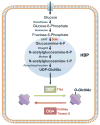O-GlcNAc and the cardiovascular system
- PMID: 24287310
- PMCID: PMC3943723
- DOI: 10.1016/j.pharmthera.2013.11.005
O-GlcNAc and the cardiovascular system
Abstract
The cardiovascular system is capable of robust changes in response to physiologic and pathologic stimuli through intricate signaling mechanisms. The area of metabolism has witnessed a veritable renaissance in the cardiovascular system. In particular, the post-translational β-O-linkage of N-acetylglucosamine (O-GlcNAc) to cellular proteins represents one such signaling pathway that has been implicated in the pathophysiology of cardiovascular disease. This highly dynamic protein modification may induce functional changes in proteins and regulate key cellular processes including translation, transcription, and cell death. In addition, its potential interplay with phosphorylation provides an additional layer of complexity to post-translational regulation. The hexosamine biosynthetic pathway generally requires glucose to form the nucleotide sugar, UDP-GlcNAc. Accordingly, O-GlcNAcylation may be altered in response to nutrient availability and cellular stress. Recent literature supports O-GlcNAcylation as an autoprotective response in models of acute stress (hypoxia, ischemia, oxidative stress). Models of sustained stress, such as pressure overload hypertrophy, and infarct-induced heart failure, may also require protein O-GlcNAcylation as a partial compensatory mechanism. Yet, in models of Type II diabetes, O-GlcNAcylation has been implicated in the subsequent development of vascular, and even cardiac, dysfunction. This review will address this apparent paradox and discuss the potential mechanisms of O-GlcNAc-mediated cardioprotection and cardiovascular dysfunction. This discussion will also address potential targets for pharmacologic interventions and the unique considerations related to such targets.
Keywords: Heart failure; Hexosamine biosynthetic pathway; Hypertrophy; Ischemia–reperfusion injury; Mitochondria.
Copyright © 2013 Elsevier Inc. All rights reserved.
Conflict of interest statement
The authors have nothing to disclose.
Figures

Similar articles
-
O-GlcNAc signaling in the cardiovascular system.Circ Res. 2010 Jul 23;107(2):171-85. doi: 10.1161/CIRCRESAHA.110.224675. Circ Res. 2010. PMID: 20651294 Free PMC article. Review.
-
New insights: A role for O-GlcNAcylation in diabetic complications.Crit Rev Biochem Mol Biol. 2016 May-Jun;51(3):150-61. doi: 10.3109/10409238.2015.1135102. Epub 2016 Jan 24. Crit Rev Biochem Mol Biol. 2016. PMID: 26806492 Review.
-
Role of O-linked N-acetylglucosamine (O-GlcNAc) modification of proteins in diabetic cardiovascular complications.Curr Opin Pharmacol. 2021 Apr;57:1-12. doi: 10.1016/j.coph.2020.08.005. Epub 2020 Sep 13. Curr Opin Pharmacol. 2021. PMID: 32937226 Free PMC article. Review.
-
O-GlcNAcylation and oxidation of proteins: is signalling in the cardiovascular system becoming sweeter?Clin Sci (Lond). 2012 Oct;123(8):473-86. doi: 10.1042/CS20110638. Clin Sci (Lond). 2012. PMID: 22757958 Free PMC article. Review.
-
The hexosamine signaling pathway: deciphering the "O-GlcNAc code".Sci STKE. 2005 Nov 29;2005(312):re13. doi: 10.1126/stke.3122005re13. Sci STKE. 2005. PMID: 16317114 Review.
Cited by
-
Regulation of cardiac O-GlcNAcylation: More than just nutrient availability.Biochim Biophys Acta Mol Basis Dis. 2020 May 1;1866(5):165712. doi: 10.1016/j.bbadis.2020.165712. Epub 2020 Jan 31. Biochim Biophys Acta Mol Basis Dis. 2020. PMID: 32014551 Free PMC article. Review.
-
The emerging link between O-GlcNAcylation and neurological disorders.Cell Mol Life Sci. 2017 Oct;74(20):3667-3686. doi: 10.1007/s00018-017-2542-9. Epub 2017 May 22. Cell Mol Life Sci. 2017. PMID: 28534084 Free PMC article. Review.
-
AMPK activation counteracts cardiac hypertrophy by reducing O-GlcNAcylation.Nat Commun. 2018 Jan 25;9(1):374. doi: 10.1038/s41467-017-02795-4. Nat Commun. 2018. PMID: 29371602 Free PMC article.
-
Alterations in left ventricular function during intermittent hypoxia: Possible involvement of O-GlcNAc protein and MAPK signaling.Int J Mol Med. 2015 Jul;36(1):150-8. doi: 10.3892/ijmm.2015.2198. Epub 2015 Apr 24. Int J Mol Med. 2015. PMID: 25936416 Free PMC article.
-
The Glycobiology of Pulmonary Arterial Hypertension.Metabolites. 2022 Apr 1;12(4):316. doi: 10.3390/metabo12040316. Metabolites. 2022. PMID: 35448503 Free PMC article. Review.
References
-
- Broschat KO, Gorka C, Page JD, Martin-Berger CL, Davies MS, Huang HcHC, Gulve EA, Salsgiver WJ, Kasten TP. Kinetic characterization of human glutamine-fructose-6-phosphate amidotransferase i: Potent feedback inhibition by glucosamine 6-phosphate. The Journal of biological chemistry. 2002;277:14764–14770. - PubMed
-
- Marshall S, Bacote V, Traxinger RR. Discovery of a metabolic pathway mediating glucose-induced desensitization of the glucose transport system. Role of hexosamine biosynthesis in the induction of insulin resistance. The Journal of biological chemistry. 1991;266:4706–4712. - PubMed
-
- Greig KT, Antonchuk J, Metcalf D, Morgan PO, Krebs DL, Zhang JG, Hacking DF, Bode L, Robb L, Kranz C, de Graaf C, Bahlo M, Nicola NA, Nutt SL, Freeze HH, Alexander WS, Hilton DJ, Kile BT. Agm1/pgm3-mediated sugar nucleotide synthesis is essential for hematopoiesis and development. Molecular and cellular biology. 2007;27:5849–5859. - PMC - PubMed
Publication types
MeSH terms
Substances
Grants and funding
LinkOut - more resources
Full Text Sources
Other Literature Sources

